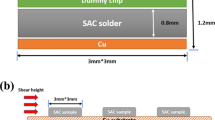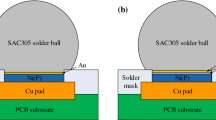Abstract
In this study, the degradation characteristics in MLCCs SAC305 lead-free solder joints were verified by thermal shock testing (from −40°C to 125°C). The thermal stress distribution in the solder joints was simulated utilizing ANSYS 13.0 and the thermal stress concentration was verified between the Ni plating layer and Cu electrode. After the test, the degradation of the mechanical characteristics was compared by conducting shear tests. The shear force decreased by 21.1% after 1200 cycles in C1608. In the case of C1005, the shear force decreased by 21.3% after 1000 cycles. The Ni3Sn4 IMCs were confirmed at the starting point at the shear fracture surface through ingredient analysis after the thermal shock test. Also, by observation of the cross-sections before and after the test, cracks were verified after thermal shock at the 1400th cycle. The cracks formed between the Ni plating layer and the solder joint. After the 1800th cycle, the Ni3Sn4 IMC thickness in C1608 grew to 8 μm. In C1005, the IMC thickness increased to 9 μm. Therefore, the Ni3Sn4 IMC growth affected the degradation and reliability reduction characteristics in the MLCC SAC305 lead-free solder joints. In the future, research aimed at preventing Ni3Sn4 IMCs should be carried out.
Similar content being viewed by others
Abbreviations
- SCR:
-
Solder-joint Crack Ratio
References
Chan, S. I., Kang, J. H., and Jang, J. S., “Reliability Improvement of Automotive Electronics based on Environmental Stress Screen Methodology, Microelectronics Reliability, Vol. 53, No. 9, pp. 1235–1238, 2013.
Lall, P., Islam, M. N., Singh, N., Suhling, J. C., and Darveaux, R., “Model for BGA and CSP Reliability in Automotive Underhood Applications, IEEE Transactions on Components and Packaging Technologies, Vol. 27, No. 3, pp. 585–593, 2004.
Jeon, Y.-J., Kim, D.-S., and Shin, Y.-E., “Study of Characteristics of Solar Cells through Thermal Shock and High-Temperature and High-Humidity Testing, Int. J. Precis. Eng. Manuf., Vol. 15, No. 2, pp. 355–360, 2014.
Yang, Z. J., Yang, S. M., Yu, H. S., Kang, S. J., Song, J. H., and Kim, K. J., “IMC and Creep Behavior in Lead-Free Solder Joints of Sn-Ag and Sn-Ag-Cu Alloy System by SP Method, International Journal of Automotive Technology, Vol. 15, No. 7, pp. 1137–1142, 2014.
Yang, Z.-J., Yu, H.-S., Yang, S.-M., Song, J.-H., and Park, S.-Y., “Prediction of Steady-State Creep Strain Rate and Rupture Life for Snag-based Lead-Free Solder Joints by SP Test, Int. J. Precis. Eng. Manuf., Vol. 14, No. 7, pp. 1245–1250, 2013.
Kang, M.-S., Jeon, Y.-J., Kim, D.-S., and Shin, Y.-E., “Evaluation of the Characteristics of 305SAC Lead-Free Solder Joints between a Chip Electrode and a Cu-Pad in Automotive Electronics, Int. J. Precis. Eng. Manuf., Vol. 16, No. 12, pp. 2483–2490, 2015.
Beyer, H.-G., Sivasubramaniam, V., Hajas, D., Nanser, E., and Brem, F., “Reliability Improvement of Large Area Soldering Connections by Antimony Containing Lead-Free Solder, Proc. of International Exhibition and Conference for Power Electronics, Intelligent Motion, Renewable Energy and Energy Management; pp. 1–8, 2014.
Cucu, T. C., Plotog, I., and Branzei, M., “Mechanical Tests Regarding Low-Temperature Lead-Free Solder Pastes Application in Automotive Electronics, Proc. of IEEE 20th International Symposium for Design and Technology in Electronic Packaging (SIITME), pp. 63–68, 2014.
Lau, J. H., “Solder Joint Reliability: Theory and Applications, Springer Science & Business Media, pp. 306–333, 1991.
Akay, H. U., Paydar, N. H., and Bilgic, A., “Fatigue Life Predictions for Thermally Loaded Solder Joints using a Volume-Weighted Averaging Technique, Journal of Electronic Packaging Transactions-American Society of Mechanical Engineers, Vol. 119, No. 4, pp. 228–235, 1997.
Johnson, R. W., Evans, J. L., Jacobsen, P., Thompson, J. R., and Christopher, M., “The Changing Automotive Environment: High-Temperature Electronics, IEEE Transactions on Electronics Packaging Manufacturing, Vol. 27, No. 3, pp. 164–176, 2004.
Hong, W. S. and Oh, C. M., “Degradation Behavior of Solder Joint and Implementation Technology for Lead-Free Automotive Electronics, Journal of Welding and Joining, Vol. 31, No. 3, pp. 22–30, 2013.
Park, J. W., Chae, J. H., Park, I. H., Youn, H. J., and Moon, Y. H., “Thermo-Mechanical Stresses and Mechanical Reliability of Multilayer Ceramic Capacitors (MLCC), Journal of the American Ceramic Society, Vol. 90, No. 7, pp. 2151–2158, 2007.
Laurila, T., Vuorinen, V., and Kivilahti, J., “Interfacial Reactions between Lead-Free Solders and Common base Materials, Materials Science and Engineering: R: Reports, Vol. 49, No. 1, pp. 1–60, 2005.
Kang, S. K., Shih, D.-Y., Fogel, K., Lauro, P., Yim, M.-J., et al., “Interfacial Reaction Studies on Lead (Pb)-Free Solder Alloys, IEEE Transactions on Electronics Packaging Manufacturing, Vol. 25, No. 3, pp. 155–161, 2002.
Sohn, Y., Yu, J., Kang, S. K., Shih, D., and Lee, T., “Effect of Intermetallics Spalling on the Mechanical Behavior of Electroless Ni (P)/Pb-Free Solder Interconnection, Proc. of IEEE Electronic Components and Technology Conference, pp. 83–88, 1999. 2005.
Shiau, L. C., Ho, C. E., and Kao, C. R., “Reactions between Sn-Ag-Cu Lead-Free Solders and the Au/Ni Surface Finish in Advanced Electronic Packages, Soldering & Surface Mount Technology, Vol. 14, No. 3, pp. 25–29, 2002.
Tegehall, P.-E., “Review of the Impact of Intermetallic Layers on the Brittleness of Tin-Lead and Lead-Free Solder Joints, IVF Project Report, Vol. 6, No. 7, pp. 1–63, 2006.
Yoon, J.-W., Kim, S.-W., and Jung, S.-B., “IMC Growth and Shear Strength of Sn-Ag-Bi-In/Au/Ni/Cu BGA Joints during Aging, Materials Transactions, Vol. 45, No. 3, pp. 727–733, 2004.
Mita, M., Kajihara, M., Kurokawa, N., and Sakamoto, K., “Growth Behavior of Ni3Sn4 Layer during Reactive Diffusion between Ni and Sn at Solid-State Temperatures, Materials Science and Engineering: A, Vol. 403, No. 1, pp. 269–275, 2005.
Ratchev, P., Vandevelde, B., and De Wolf, I., “Reliability and Failure Analysis of Sn-Ag-Cu Solder Interconnections for PSGA Packages on Ni/Au Surface Finish, IEEE Transactions on Device and Materials Reliability, Vol. 4, No. 1, pp. 5–10, 2004.
Tu, P. L., Chan, Y. C., and Lai, J. K., “Effect of Intermetallic Compounds on Vibration Fatigue of ìBGA Solder Joint, IEEE Transactions on Advanced Packaging, Vol. 24, No. 2, pp. 197–205, 2001.
Chiu, T.-C., Zeng, K., Stierman, R., Edwards, D., and Ano, K., “Effect of Thermal Aging on Board Level Drop Reliability for Pb-Free BGA Packages, Proc. of IEEE Electronic Components and Technology Conference, pp. 1256–1262, 2004.
Dusek, M., Wickham, M., and Hunt, C., “The Impact of Thermal Cycling Regime on the Shear Strength of Lead-Free Solder Joints, Soldering & Surface Mount Technology, Vol. 17, No. 2, pp. 22–31, 2005.
Vandevelde, B., Gonzalez, M., Limaye, P., Ratchev, P., and Beyne, E., “Thermal Cycling Reliability of SnAgCu and SnPb Solder Joints: A Comparison for Several Ic-Packages, Microelectronics Reliability, Vol. 47, No. 2, pp. 259–265, 2007.
Author information
Authors and Affiliations
Corresponding author
Rights and permissions
About this article
Cite this article
Kang, MS., Jeon, YJ., Kim, DS. et al. Degradation characteristics and Ni3Sn4 IMC growth by a thermal shock test in SAC305 solder joints of MLCCs applied in automotive electronics. Int. J. Precis. Eng. Manuf. 17, 445–452 (2016). https://doi.org/10.1007/s12541-016-0055-3
Received:
Revised:
Accepted:
Published:
Issue Date:
DOI: https://doi.org/10.1007/s12541-016-0055-3




